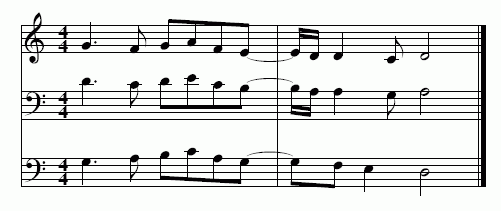| Gymel, fauxbourdon The 15th century Guilhelmus Monachus speaks about cantus gymellus (= two part song), the gymel, referring to a typical English form of polyphony with parallel thirds, sixths or tenths. According to Monachus this was a musical practice in the 13th century. Around 1300 the gymel was extended from a parallel two part motion to three part, parallel sixth chords (= parallel third and sixth). For this we use the term 'faux bourdon' (also: fauxbourdon). In England, this fauxbourdon was also called 'descant', because the main melody lied in the upper voice (treble, discantus). In the compositions of the astronomer and musician John Dunstable (ca. 1390-1453) - considered as a leading English composer and as an important link between the medieval Ars Nova and the Renaissance Dutch schools - we find the faux bourdon often.  |